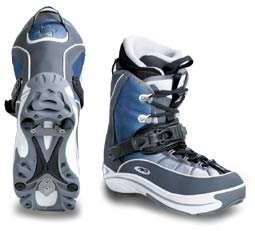If you’re new to snowboarding and trying to decide
whether to go with traditional strap bindings or a step-in system like the K2-Clicker,
Switch, Rossignol or Ride/Device System, what should you consider? Asides from
cost, understanding some performance, comfort and ease-of-adjustment issues
can help you make your decision.
n
|
|
Traditional strap binding systems excel in adjustability. You can ratchet them
as tight as you want them, quickly and easily. They don’t require boots that
fit perfectly. You can wear boots that are a little looser, and consequently
warmer and more comfortable. At the top of each run, riders will crank their
heel straps down tight to prevent heel lift, and before they get back on the
lift loosen their straps back up to restore circulation.
Step-in systems offer one unbeatable advantage over traditional strap bindings—speed
of entry and exit. While this is most visible exiting the lifts, it’s when
you get stranded on the flats and have to skate that a quick release and re-entry
truly shines. Beginners probably benefit more from step-ins than experts in
this regard. With step-ins, there’s no more bending over or sitting on the cold
ground to strap in while your buddies on skis patiently wait for you. The ability
to get out of one’s bindings quickly may also add to safety if you ride
in deep powder or the backcountry.
With second-generation step-in systems, adjustments are almost as good as with
straps. Most of the second generation step-in boots now have a "power strap"
you can ratchet down to reduce heel lift. This is a big improvement over the
first generation boots, where your only adjustment was stopping and relacing
your boots, or putting on another pair of socks.
Whether you’re on skis or a snowboard, snow is going to stick to the bottom
of your boots. With strap bindings you don’t have to scrape the last bit
of snow off the bottom of your boot or binding in order to strap in. The question
with any step-in system is how much snow you have to remove before you can successfully
engage the binding. Does engaging the binding help shove snow out of the way?
Does the binding self-tighten as remaining snow melts away? In this regard,
the Switch system is superior to all but traditional strap systems. With a traditional
strap binding, if snow between your boot and the binding melts or evaporates
and they start getting loose, a few quick clicks of the ratchet gets you tight
again.
In first-generation step-ins the high back became an integral part of the boot
rather than the binding. Step-in boots became stiffer and harder to walk in
than traditional snowboard boots, as well as more expensive. Second-generation
step-ins have brought back the external high-back which riders seem to prefer.
It also helps keep the cost of the boot down, which is important for retailers.
Manufacturers of both types of boots have come up with a variety of fixes to
minimize heel lift, which is what happens when you’re making toeside turns
in a boot that doesn’t fit snugly enough around your heel. These include
"power straps," internal laces, and so on. With traditional bindings
and a soft enough boot one can simply ratchet the straps down tighter to compress
the boot and reduce heel lift. Personally, I’ve found heel pads, which are small
wedges of foam you put under your heel, help tremendously.
A downside of strap bindings is that your feet tend to get wetter. Snow accumulates
on the tongue and around the laces. Your strap goes over that and tightens down.
A combination of the strap’s pressure and your foot’s warmth melts
the snow in the one place where it can seep right in and make your feet wet.
On powder days this can be a problem. Step-ins probably stay a bit drier because
snow can simply evaporate to the atmosphere off the top of the boot.
Step-in systems’ popularity comes from an entirely different angle: Rental
shops. With step-in systems all a shop has to do is rent you the correct size
boot. Time-consuming binding adjustments are eliminated and rookies can’t
break ratchet levers by forcing them the wrong direction.
My advice? Try both step-in systems and traditional ratchet bindings before
you buy. Unless you’re a never-ever-ever, you’ll know within a matter
of hours which you prefer.



